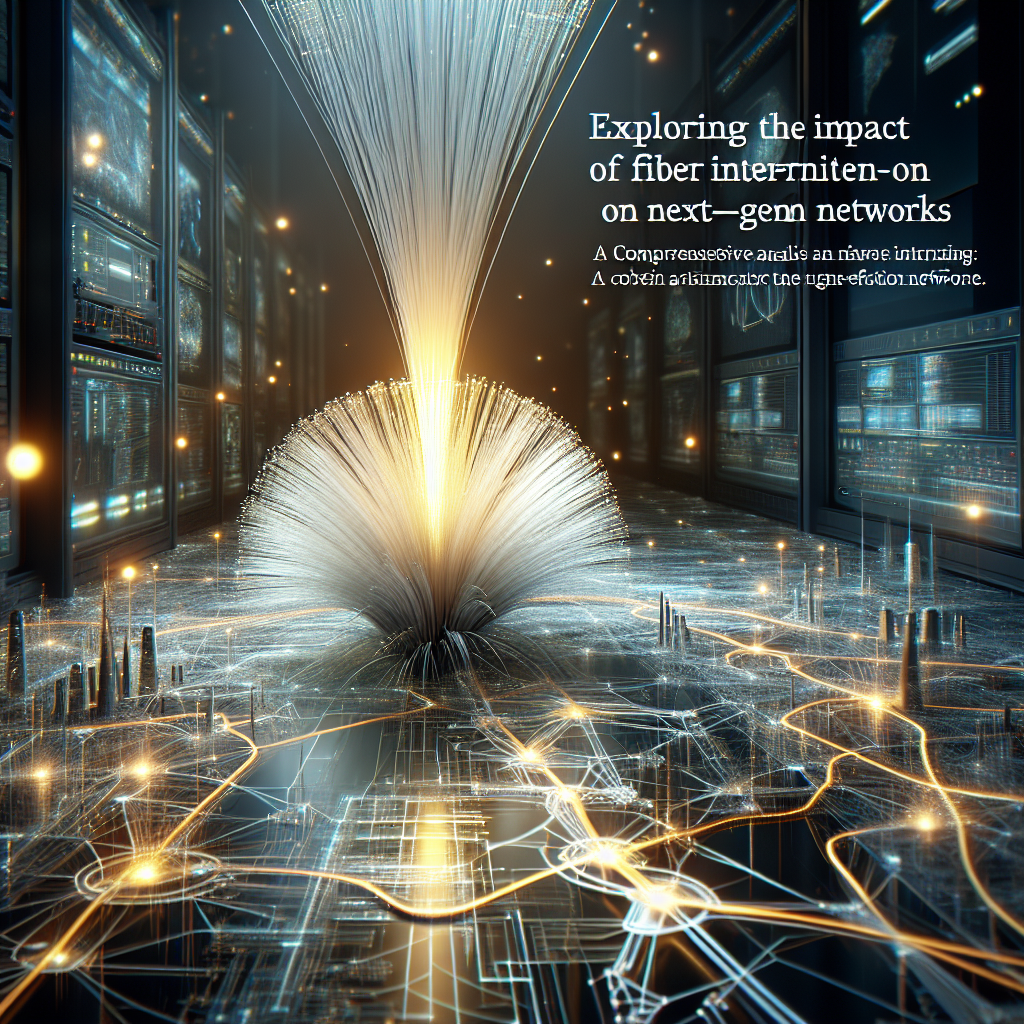In the ever-evolving landscape of technology, the role of fiber internet in shaping next-generation networks cannot be overstated. Fiber optic cables have revolutionized the way data is transmitted, offering lightning-fast speeds and unparalleled reliability. This comprehensive analysis delves deep into the impact of fiber internet on the future of connectivity, exploring how it is driving innovation in industries, enabling seamless communication, and paving the way for advanced technologies such as 5G and Internet of Things (IoT). Join us on a journey through the intricate web of fiber optics, as we uncover the crucial role it plays in shaping the networks of tomorrow.
Understanding Fiber Internet in Next-Gen Networks
Fiber Internet, also known as fiber-optic Internet, is a type of broadband connection that utilizes fiber-optic cables to transmit data at incredibly high speeds. These cables consist of thin strands of glass or plastic that use light to carry information, allowing for faster and more reliable data transmission compared to traditional copper cables.
Definition of Fiber Internet
Fiber Internet is characterized by its ability to deliver symmetrical upload and download speeds, providing a more consistent and seamless online experience for users. This technology is capable of supporting large amounts of data with minimal latency, making it ideal for applications that require real-time connectivity, such as online gaming, video conferencing, and cloud computing.
Evolution of Fiber Internet in Telecommunications
Over the years, fiber Internet has evolved from being a premium service offered to select businesses and residential areas to becoming a fundamental component of modern telecommunications infrastructure. As demand for high-speed Internet continues to rise, service providers have been expanding their fiber-optic networks to reach more customers and deliver faster connectivity.
Importance of Fiber Internet for Next-Generation Networks
In the context of next-generation networks, fiber Internet plays a crucial role in enabling the deployment of advanced technologies such as 5G, Internet of Things (IoT), and smart cities. The scalability and speed of fiber-optic connections provide the necessary foundation for supporting the increasing number of devices and applications that rely on high-speed data transfer and low latency. As the digital landscape evolves, fiber Internet will be instrumental in shaping the future of connectivity and innovation.
Benefits of Fiber Internet in Next-Gen Networks

Fiber Internet is revolutionizing next-generation networks by providing a multitude of benefits that significantly enhance network performance and capabilities. Understanding these advantages is crucial for grasping the full impact of fiber technology on evolving network infrastructures.
High-Speed Connectivity
Incorporating fiber Internet into next-gen networks results in unparalleled speed capabilities. Fiber-optic cables transmit data at the speed of light, offering incredibly fast download and upload speeds. This rapid data transmission enables seamless streaming, quick file transfers, and lag-free online experiences. As the demand for high-bandwidth applications continues to grow, the speed of fiber Internet becomes indispensable in ensuring efficient network operations.
Low Latency and Reliability
One of the distinctive features of fiber Internet is its low latency, which refers to the minimal delay in data transmission. Compared to traditional copper cables, fiber optics reduce latency significantly, making real-time communication and interactive applications more responsive. Additionally, fiber Internet boasts exceptional reliability, as the cables are immune to electromagnetic interference and inclement weather conditions. This reliability ensures consistent network performance, minimizing downtime and disruptions in critical operations.
Scalability and Bandwidth Capacity
Fiber Internet offers unmatched scalability and bandwidth capacity, making it an ideal choice for next-gen networks that require flexibility and expansion capabilities. Fiber-optic cables can support a vast amount of data without compromising speed or quality, allowing networks to easily accommodate increasing data traffic and evolving technological requirements. The high bandwidth capacity of fiber Internet enables seamless integration of advanced services, such as cloud computing, IoT devices, and high-definition video streaming, without experiencing bottlenecks or performance degradation.
Challenges and Misconceptions Surrounding Fiber Internet
Cost Implications
Fiber internet is often perceived as a costly infrastructure to deploy and maintain. While the initial investment in fiber optic cables and network equipment can be higher than traditional copper-based systems, the long-term cost savings and efficiency of fiber networks are significant. The total cost of ownership of fiber internet, when considering factors like durability, bandwidth capabilities, and future-proofing, often outweighs the upfront expenses.
Deployment Challenges
The physical deployment of fiber optic cables can present challenges due to the need for specialized installation techniques and equipment. Excavation for laying fiber cables underground or on utility poles requires careful planning to avoid disruptions to existing infrastructure and ensure proper network connectivity. Additionally, navigating regulatory approvals and permitting processes can slow down deployment timelines, adding complexity to the implementation of fiber internet networks.
Myths vs. Realities of Fiber Internet
There are several misconceptions surrounding fiber internet, including concerns about its reliability during inclement weather and susceptibility to physical damage. In reality, fiber optic cables are highly resilient to environmental factors and interference, making them more reliable than traditional copper cables. Another common myth is that fiber internet is only beneficial for large-scale enterprises, while in truth, fiber connectivity offers advantages for businesses of all sizes, improving speed, security, and scalability of network operations.
Role of Fiber Internet in Enhancing Network Security
Fiber Internet plays a crucial role in enhancing network security through various mechanisms that ensure the protection and integrity of data transmission and storage. By leveraging the capabilities of fiber optic technology, organizations can significantly bolster their cybersecurity measures and mitigate potential risks associated with cyber threats.
Encrypted Data Transmission
One of the key advantages of fiber Internet in enhancing network security is its ability to facilitate encrypted data transmission. Fiber optic cables enable the secure transfer of data over long distances without being vulnerable to interception or eavesdropping. By leveraging encryption protocols, organizations can ensure that sensitive information remains confidential and protected from unauthorized access.
Protection Against Cyber Threats
Fiber Internet provides a robust defense against a wide range of cyber threats, including malware, phishing attacks, and data breaches. The high-speed and reliable connectivity offered by fiber optic networks enable real-time monitoring and threat detection, allowing organizations to promptly respond to security incidents and prevent potential breaches. Additionally, the low latency of fiber Internet enhances the effectiveness of security measures, ensuring rapid and efficient communication between network devices.
Secure Data Storage and Backup
Incorporating fiber Internet into network infrastructure enhances the security of data storage and backup processes. With faster and more reliable connectivity, organizations can efficiently store and retrieve critical information without compromising data integrity or availability. Fiber optic technology enables secure data replication and backup procedures, reducing the risk of data loss and ensuring business continuity in the event of a cybersecurity incident.

Integration of Fiber Internet with Emerging Technologies
Fiber Internet plays a pivotal role in the seamless integration of various emerging technologies, enhancing their performance and reliability. The high-speed and low-latency nature of fiber optic connections enables the efficient deployment and operation of cutting-edge applications and services. Let’s delve into how fiber Internet is intricately linked with the following emerging technologies:
Internet of Things (IoT) Connectivity
Fiber Internet acts as the backbone for robust IoT connectivity, facilitating the transfer of massive amounts of data between interconnected devices. With the exponential growth of IoT devices in various sectors such as smart homes, healthcare, and industrial automation, the reliability and bandwidth capabilities of fiber optic networks are instrumental in ensuring uninterrupted communication and data exchange. The low latency of fiber Internet enables real-time monitoring and control of IoT devices, enhancing overall system efficiency and responsiveness.
5G Network Support
The rollout of 5G networks has ushered in a new era of ultra-fast mobile connectivity and innovative services. Fiber Internet infrastructure serves as the ideal backhaul for 5G networks, providing the necessary bandwidth and speed to support the increased data traffic generated by 5G-enabled devices. By leveraging fiber optic connections, telecom operators can deliver high-speed 5G services to end-users without compromising on performance or reliability. The synergy between fiber Internet and 5G technology paves the way for enhanced mobile experiences and enables the widespread adoption of bandwidth-intensive applications like augmented reality and virtual reality.
Cloud Computing and Edge Computing Applications

Cloud computing and edge computing rely on robust network connectivity to deliver on-demand services and process data in real-time. Fiber Internet offers the high bandwidth and symmetrical upload and download speeds required for seamless cloud computing operations. By leveraging fiber optic connections, businesses can efficiently migrate their workloads to the cloud, ensuring scalability and flexibility in resource allocation. Additionally, fiber Internet enhances the performance of edge computing applications by reducing latency and enabling quick data processing at the network edge. This integration of fiber Internet with cloud computing and edge computing technologies accelerates digital transformation initiatives and empowers organizations to harness the full potential of distributed computing architectures.
Future Prospects and Innovations in Fiber Internet Technology
Fiber Optic Innovations
Fiber internet technology continues to evolve, with ongoing innovations in fiber optic infrastructure. One of the key advancements in this realm is the development of hollow core fibers, which have the potential to significantly increase data transmission speeds. By utilizing air or a vacuum instead of traditional glass materials for data transmission, these fibers offer lower latency and higher bandwidth capacity, paving the way for enhanced network performance.
Expansion of Fiber Networks
The expansion of fiber networks is a crucial aspect of future prospects in fiber internet technology. With the increasing demand for high-speed and reliable internet connectivity, telecom companies and service providers are investing in the deployment of fiber optic cables to reach more users. This expansion not only enhances internet accessibility in urban areas but also brings high-speed connectivity to rural and underserved regions, bridging the digital divide and fostering economic growth.
Impact on Smart Cities and Digital Transformation
The integration of fiber internet technology plays a pivotal role in the development of smart cities and digital transformation initiatives. By leveraging the high bandwidth capabilities of fiber optics, smart city projects can deploy advanced technologies such as IoT sensors, smart grids, and autonomous vehicles, enhancing urban efficiency and sustainability. Furthermore, fiber internet enables seamless connectivity for digital services, promoting innovation in sectors like healthcare, education, and transportation, thereby driving overall economic development and societal progress.
FAQs for Exploring the Impact of Fiber Internet on Next-Gen Networks: A Comprehensive Analysis
What is the role of fiber internet in next-generation networks?
Fiber internet plays a crucial role in next-generation networks by providing high-speed and reliable connectivity. Fiber optic cables are capable of carrying large amounts of data at incredibly fast speeds, making them ideal for supporting the demands of modern applications and technologies. As next-gen networks continue to evolve and expand, fiber internet will be essential in meeting the growing bandwidth requirements and ensuring seamless connectivity for users.
How does fiber internet contribute to the development of smart cities and IoT applications?
Fiber internet is a key enabler for smart cities and IoT applications, as it forms the backbone of the infrastructure needed to support these technologies. With its high-speed and low latency capabilities, fiber internet enables the real-time communication and data processing that are essential for the functioning of smart devices and sensors in a connected environment. By providing a reliable and fast connection, fiber internet paves the way for the development of innovative solutions that can improve the efficiency and sustainability of urban areas.
What are the main advantages of using fiber internet in next-gen networks?
Fiber internet offers several advantages for next-gen networks, including faster speeds, greater reliability, and increased bandwidth capacity. By leveraging fiber optic technology, network operators can deliver high-quality services to users and support a wide range of applications, such as high-definition video streaming, online gaming, and cloud computing. Additionally, fiber internet is more durable and secure than traditional copper-based connections, making it a preferred choice for businesses and residential users alike.
How is fiber internet expected to shape the future of communication and connectivity?
Fiber internet is expected to play a significant role in shaping the future of communication and connectivity by enabling the development of advanced network infrastructures and services. As demand for high-speed internet continues to grow, fiber optic technology will become increasingly important in delivering the fast and reliable connections that users rely on for work, entertainment, and social interactions. By investing in fiber internet infrastructure, countries can position themselves for future growth and innovation in the digital age.
